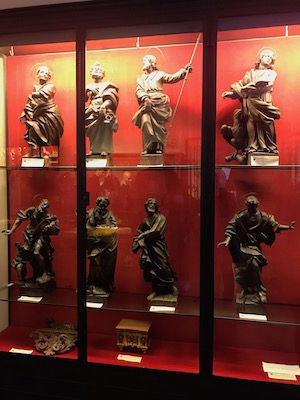Siena Duomo Complex
- Amy Unfried
- Apr 28, 2019
- 3 min read
On Saturday, since Steve had observed that the lines for the key local sights get very long quite early in the day, we got up early enough to be in line at 9:30 for the ticket office for the Duomo and its museum complex. As a result, by the 10:00 opening time we were not far back in the line to enter the Museo dell'Opera. Similar to the Museo dell'Opera del Duomo in Florence, it houses works of art that used to be part of the cathedral, either on the facade or inside, but that have been removed to be conserved or replaced for other reasons. It's much smaller than Florence's, but there are some beautiful or otherwise fascinating objects on display. Here are a few I particularly liked:

This is part of a set of apostles by a Baroque-era sculptor--they all seem to be dancing! Can't you hear that celestial jazz?!

One room is entirely given over to detailed renderings of the elaborate etched and inlaid marble floors of the Duomo. For most of the year, except for a brief interval, the floors and the stories they depict are almost entirely are covered with protective materials, and the parts that are uncovered are roped off so that they can be seen without being stepped on. The drawings in this room show all the pictures, many of which tell dramatic and violent stories such as battles and the Massacre of the Innocents, while other pictures depict the Sibyls (female oracles of ancient Greece) and Old Testament prophets, along with texts in which these seers foretold elements of the story of Jesus. One time when we were in Siena we did see the whole floor uncovered, which was a treat, but this room enabled us to see the floor as a whole. Here's a detail I enjoyed: a lion and a wolf shaking paws. I wonder what the Hellespontine Sibyl (also known as the Trojan Sibyl) said to prompt that image?

Another room held a wooden Crucifixion scene, with saints: here is Saint John the apostle, grieving at the foot of the cross. It is such a realistic portrayal of a (particular) human being's anguish. Imagine being the model who had to pose like that.

In the same room was a half-life-size carving of St. John the Baptist, and this face is also remarkable for its departure from the generic or abstract. This really looks like that crazy guy who lived in the desert eating locusts, shouting at people that they were a nest of vipers.

Part of a long series of small (about a foot-square) scenes from the life of Christ, this picture shows the First Miracle, the changing of water into wine at the wedding at Cana. Seated at the table are Jesus and Mary and several disciples with haloes, and the foreground has the action: the servants pouring wine into small jugs and cups, from the larger jugs that they have filled with water per Jesus' instructions. The left-most boy in green is scratching his head in bewilderment.
After we finished looking at the art, we declined the opportunity to get into another line to climb up to the top of the high, dominating wall that was to have been the facade of the Gothic cathedral if it had been expanded according to plan in the fourteenth century. What is now (still) the nave would have been downgraded to a transept, and when finished the cathdral would have been more than twice as large as it is now. However, the Black Plague of 1348 intervened, and the local population and work force were decimated, so the construction that had begun was stopped and never restarted. Still, one can climb up in two stages to the top of the wall -- called il Facciatone, the big facade -- and to get what I'm sure is a fantastic view of the whole countryside around Siena, and it would have been a beautiful day to do that, but there are at a minimum a hundred steps up to the top, and my knees weren't up to that.

Consequently we went down to the ground level and paid another visit to the Duomo.
The Duomo's west portal--its facade, here seen before the crowds arrived-- is a remarkable work, with candy-colored columns surrounding its three doors and thousands of component works of art covering the skin of the edifice.
Inside it is equally ornate, from its clusters of striped columns to the star-studded vaulted ceilings to the huge pulpit supported by four lions (the females are suckling cubs, the males are devouring some kind of antelope). And then there are the magnificent floors mentioned above.

The Piccolomini Library off at one side houses a collection of large illuminated choir books--big enough so that the whole choir could read them at once--and the frescoed walls tell the story of a famous member of the Piccolomini family who became Pope Pius II, from 1503 to 1508.









Comments